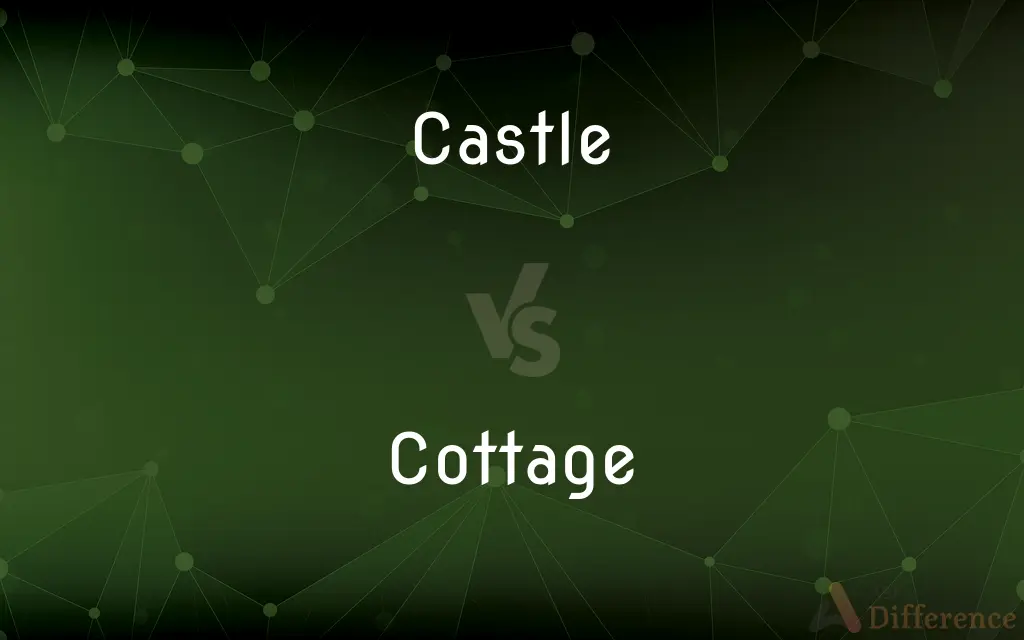Castle vs. Cottage — What's the Difference?
By Tayyaba Rehman & Urooj Arif — Updated on March 6, 2024
A castle is a large, fortified residence of nobility, often historical and luxurious, while a cottage is a small, cozy house typically found in rural areas.

Difference Between Castle and Cottage
Table of Contents
ADVERTISEMENT
Key Differences
Castles are grand structures designed for defense and to display the wealth and power of their inhabitants. They are often associated with medieval Europe, featuring towers, battlements, and sometimes moats. Castles served as both military fortresses and noble residences, embodying the feudal system's hierarchy. On the other hand, cottages are modest, single-family dwellings, characterized by their simple architecture and use in various cultural contexts. They are often made from local materials, such as wood or stone, and are designed to be functional and comfortable for their inhabitants, rather than for defense or display of wealth.
While castles are built with durability and protection in mind, incorporating thick walls, sturdy gates, and strategic positions to withstand sieges, cottages prioritize harmony with their natural surroundings. This focus on environment-friendly and sustainable living contrasts sharply with the military and ostentatious purposes of castles.
Cottages, with their smaller size and emphasis on coziness, often feature gardens or small land plots where occupants can grow their own food or enjoy nature. This connection to the land and simplicity of life is in stark contrast to the vast estates and formal gardens that typically surround castles, highlighting different lifestyles and values.
The cultural and historical significance of castles reflects their role in historical conflicts, governance, and as symbols of power. They are frequently maintained as tourist attractions or historical sites. Cottages, while less grandiose, hold cultural significance in depicting rural life, traditional crafts, and community living, often embodying ideals of simplicity and escape from the complexities of modern life.
Comparison Chart
Purpose
Defense, power display, noble residence
Cozy living, simplicity
ADVERTISEMENT
Size and Complexity
Large, complex with multiple rooms and defensive features
Small, simple, often one or two rooms
Materials
Stone, brick for durability and defense
Wood, stone, local materials for comfort
Historical Significance
Symbol of feudal hierarchy, military strength, historical conflicts
Emblem of rural life, simplicity, craftsmanship
Cultural Representation
Associated with nobility, historical battles, and governance
Symbolizes coziness, simplicity, connection to nature
Compare with Definitions
Castle
A residence of a monarch or noble, marked by its grandeur and historical significance.
The king's castle was not just his home but a symbol of his reign.
Cottage
A small, simple house, typically in a rural or semi-rural location.
The cozy cottage nestled in the woods offered a peaceful retreat.
Castle
An imposing and majestic building, resembling medieval castles.
The modern castle-like mansion dominated the landscape with its impressive architecture.
Cottage
A seasonal residence, used for holidays or vacations.
They spent every summer at their family cottage on the coast.
Castle
A place of refuge or stronghold, sometimes used metaphorically.
In times of turmoil, the city acted as a castle for its citizens.
Cottage
A structure built for comfort and efficiency, reflecting local architectural styles.
The stone cottage blended seamlessly with the surrounding landscape.
Castle
A large building fortified against attack with thick walls, battlements, and often a moat.
The medieval castle stood tall, its stone walls witnessing centuries of history.
Cottage
Symbolic of simplicity and a return to nature or traditional values.
Moving to a cottage in the countryside was their dream of a simpler life.
Castle
A large fortified building or group of buildings with thick walls, usually dominating the surrounding country.
Cottage
A dwelling characterized by its modesty and charm, often associated with country living.
Their vacation cottage by the lake was the perfect getaway.
Castle
To place in or as if in a castle.
Cottage
A cottage is typically a small house. It may carry the connotation of being an old or old-fashioned building.
Castle
In chess, a move involving the rook and king for defense.
He decided to castle early in the game to secure his king's safety.
Cottage
A small house, typically one in the country
A holiday cottage
Castle
A castle is a type of fortified structure built during the Middle Ages predominantly by the nobility or royalty and by military orders. Scholars debate the scope of the word castle, but usually consider it to be the private fortified residence of a lord or noble.
Cottage
A small, single-storied house, especially in the country.
Castle
A fortified stronghold converted to residential use.
Cottage
A usually small vacation house.
Castle
A large ornate building similar to or resembling a fortified stronghold.
Cottage
A small house.
Castle
A place of privacy, security, or refuge.
Cottage
A seasonal home of any size or stature, a recreational home or a home in a remote location.
Most cottages in the area were larger and more elaborate than my home.
Castle
(Games) See rook2.
Cottage
A public lavatory.
Castle
To move the king in chess from its own square two empty squares to one side and then, in the same move, bring the rook from that side to the square immediately past the new position of the king.
Cottage
To stay at a seasonal home, to go cottaging.
Castle
(Games) To move (the king in chess) by castling.
Cottage
A small house; a cot; a hut.
Castle
A large residential building or compound that is fortified and contains many defences; in previous ages often inhabited by a nobleman or king. Also, a house or mansion with some of the architectural features of medieval castles.
Cottage
A small house with a single story
Castle
(chess) An instance of castling.
Castle
A rook; a chess piece shaped like a castle tower.
Castle
(shogi) A defense structure in shogi formed by defensive pieces surrounding the king.
Castle
(obsolete) A close helmet.
Castle
(dated) Any strong, imposing, and stately palace or mansion.
Castle
(dated) A small tower, as on a ship, or an elephant's back.
Castle
The wicket.
Castle
(transitive) To house or keep in a castle.
Castle
To protect or separate in a similar way.
Castle
(obsolete) To make into a castle: to build in the form of a castle or add (real or imitation) battlements to an existing building.
Castle
To move the king 2 squares right or left and, in the same turn, the nearest rook to the far side of the king. The move now has special rules: the king cannot be in, go through, or end in check; the squares between the king and rook must be vacant; and neither piece may have been moved before castling.
Castle
To create a similar defensive position in Japanese chess through several moves.
Castle
(cricket) To bowl a batsman with a full-length ball or yorker such that the stumps are knocked over.
Castle
A fortified residence, especially that of a prince or nobleman; a fortress.
The house of every one is to him castle and fortress, as well for his defense againts injury and violence, as for his repose.
Our castle's strengthWill laugh a siege to scorn.
Castle
Any strong, imposing, and stately mansion.
Castle
A small tower, as on a ship, or an elephant's back.
Castle
A piece, made to represent a castle, used in the game of chess; a rook.
Castle
To move the castle to the square next to king, and then the king around the castle to the square next beyond it, for the purpose of covering the king.
Castle
A large and stately mansion
Castle
A large building formerly occupied by a ruler and fortified against attack
Castle
(chess) the piece that can move any number of unoccupied squares in a direction parallel to the sides of the chessboard
Castle
Interchanging the positions of the king and a rook
Castle
Move the king two squares toward a rook and in the same move the rook to the square next past the king
Common Curiosities
Can castles be lived in today?
Yes, some castles are still residences, while others are museums or hotels.
What is the primary purpose of a castle?
Castles were primarily built for defense and to serve as noble residences.
How did castles protect their inhabitants?
Castles protected inhabitants with features like thick walls, towers, and moats.
How do cottages reflect cultural values?
Cottages reflect values of simplicity, connection to nature, and traditional living.
Why are cottages associated with simplicity?
Cottages embody simplicity due to their modest size, design, and natural materials.
What distinguishes a castle from a palace?
Castles are fortified, while palaces are luxurious residences without defensive features.
What defines a cottage?
A cottage is defined by its small size, simplicity, and often rural setting.
Can cottages be found in urban areas?
Rarely, as cottages are typically associated with rural or semi-rural settings.
What materials are typically used to build cottages?
Cottages are typically built with local materials like wood or stone.
What is the cultural significance of castles?
Castles symbolize historical power, conflicts, and the feudal system.
Are there modern castles?
Modern buildings styled as castles exist but are more for aesthetics than defense.
Is it common for cottages to have gardens?
Yes, cottages often have gardens or small plots of land for personal use.
Why are castles often tourist attractions?
Their historical significance, architecture, and stories attract visitors.
How do castles and cottages differ in terms of architecture?
Castles feature defensive architecture, while cottages focus on coziness and simplicity.
Do cottages have historical significance?
Yes, cottages can reflect historical architectural styles and ways of life.
Share Your Discovery

Previous Comparison
Unimportant vs. Insignificant
Next Comparison
Burrito vs. BurroAuthor Spotlight
Written by
Tayyaba RehmanTayyaba Rehman is a distinguished writer, currently serving as a primary contributor to askdifference.com. As a researcher in semantics and etymology, Tayyaba's passion for the complexity of languages and their distinctions has found a perfect home on the platform. Tayyaba delves into the intricacies of language, distinguishing between commonly confused words and phrases, thereby providing clarity for readers worldwide.
Co-written by
Urooj ArifUrooj is a skilled content writer at Ask Difference, known for her exceptional ability to simplify complex topics into engaging and informative content. With a passion for research and a flair for clear, concise writing, she consistently delivers articles that resonate with our diverse audience.
















































